| Transportation Index Page | 16th OVI Home Page | Next Transportation Page |
16th Ohio Volunteer Troops
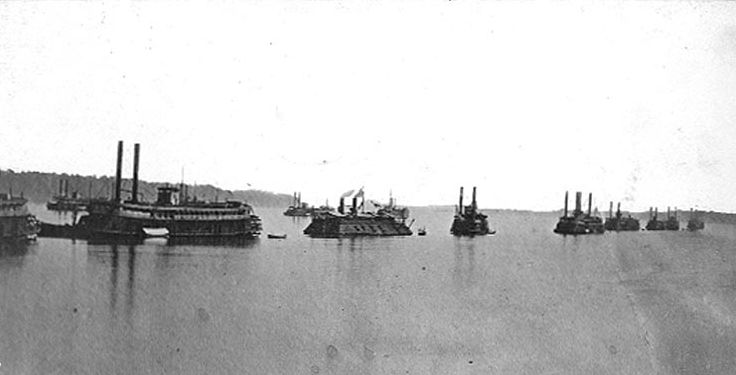
Gunboat U.S.S. Key West #3
U.S. Naval Historical Center Photograph
The 16th Ohio (or elements of) was transported by the steamer Key West No. 3 from Point Pleasant, (West) Virginia, on November 13, 1862 disembarking at Memphis, Tennessee, on November 27, 1862. The regiment was on its way to the bloody battle of Chickasaw Bayou near Vicksburg, Mississippi. The ship was soon after purchased by the U. S. Navy and converted to a gunboat. The photo above (left most complete ship) was taken off Mound City, Illinois, some time in 1863. See 16th OVI references: p. 3, Shelly Diary; Cunningham Diary; p. 21 Perrine Diary
History:
USS Key West, a 207-ton stern-wheel tinclad
river gunboat, was built in 1862 at California, Pennsylvania, as the civilian steamer Key West No. 3. Purchased by the Navy in April 1863, she was converted to a gunboat and commissioned the following month as USS Key West. She was assigned to patrol and escort duties on the Tennessee River, where she protected Union forces from Confederate raids. On 10 October 1864, Key West received damage in gunnery actions with enemy batteries during an expedition to Eastport, Mississippi. Early in November, she took part in an operation to recapture a transport steamer at Johnsonville, Tennessee, in company with the Tinclads
Elfin and Tawah. Near there on 4 November 1864, the three gunboats were trapped by Confederate artillery. After a vigorous engagement, Key West and her two consorts were burned to prevent capture.
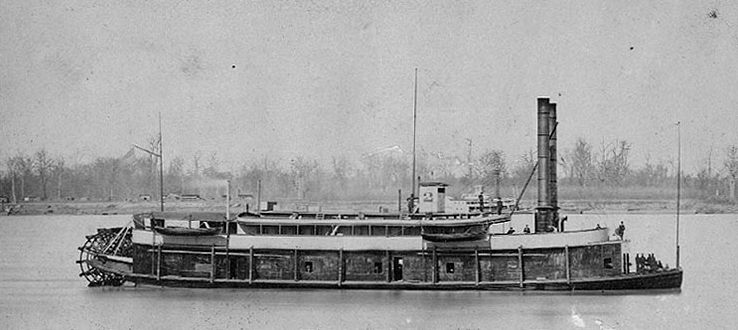
U.S.S. Marmora
(credit)
The 16th Ohio (or elements of) was transported by the steamer Marmora from Point Pleasant, (West) Virginia, on November 13, 1862 disembarking at Memphis, Tennessee, on November 27, 1862. The regiment was on its way to the bloody battle of Chickasaw Bayou near Vicksburg, Mississippi.
History:
USS Marmora was a stern wheel paddle steamer in the United States Navy. Marmora was built at Monongahela, Pennsylvania, in 1862, was purchased by the Navy at St. Louis, Missouri, on 17 September 1862 from Messrs. Brenan, Nelson, and McDonnell; and commissioned at Carondelet, Missouri, on 21 October 1862, Captain Robert Getty in command. The ship saw action at Vicksburg, Mississippi, November/December, 1862; Fort Hindman, Arkansas, January 4 to 11, 1863; Yazoo River operations, February/March, 1863; various action along Mississippi River, 1863; Yazoo City, Mississippi, March, 1864; in reserve at Mound City, Illinois until decommissioning. Three Marmora sailors were awarded the Medal of Honor for action at Yazoo City, March 5, 1864.
Name: USS Marmora
Laid down: 1862
Acquired: 17 September 1862
Commissioned: 21 October 1862
Decommissioned: 7 July 1865
Fate: Sold, 17 August 1865, to D. D. Barr
Displacement: 207 long tons (210 t)
Length: 155 ft (47 m)
Beam: 33 ft 5 in (10.19 m)
Draft: 4 ft 6 in (1.37 m)
Speed: 6.9 knots (12.8 km/h; 7.9 mph)
Armament: 8 × 24-pounder guns
2 X 12-pounder guns
6 X 14-pounder guns
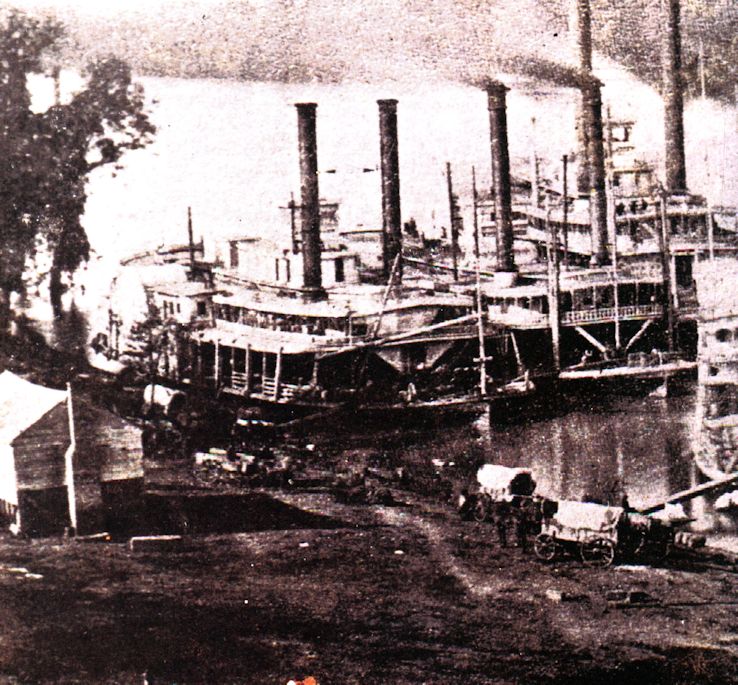
Steamboat Fanny Bullitt (?)
One of the three steamers, above, is purported to be the Fanny Bullitt by a contributor on Ancestry.com. This identification has not been confirmed at this time.
The 16th Ohio (or elements of) was transported by the steamer Fanny Bullitt from Memphis, Tennessee, on December 20, 1862 to the Yazoo River, above Vicksburg, Mississippi, where the regiment disembarked at Johnnson's Plantation, on December 26. At this time, the regiment was just a few miles northwest of Chickasaw Bluffs where, over the next four days, it would see its most severe fighting and loss at the Battle of Chickasaw Bayou. See 16th OVI references: p. 4, Shelly Diary. The 16th Ohio was assigned to the Fanny Bullitt for transportation several times during the winter of 1862/1863:
* December 20 to December 26, 1862 - from camp at Memphis, Tennessee to Battle of Chickasaw Bayou, Mississippi
* January 1 to January 9, 1863 - from the Battle of Chickasaw Bayou up the Mississippi River to Battle of Arkansas Post (Fort Hindman), Arkansas
* January 16 to January 21, 1863 - from Arkansas Post to Young's Point, Louisiana, winter camp for the regiment
* March 8, 1863 - from Young's Point, Louisiana to Milliken's Bend, Louisiana, a campground dryer than Young's Point
History:
The Fanny Bullitt was a sidewheel steamer built in 1854 at Jeffersonville, Indiana. Weight: 438 tons; Length: 245 feet; beam: 35 feet; depth: 7 feet; Snagged at Napoleon, Arkansas, on March 15, 1864 (sunk) with the Fanny Bullitt Towhead (sandbar or island) forming because of the wreck. The steamboat was majority owned by its commander, Julius Augustus Lemcke, who was barely able to keep it from falling into Confederate hands at the start of the war. One-sixth of the boat was owned by Lemcke's friend and associate, Ronald Fisher, a staunch Union man and who remained second in command of the Fanny.
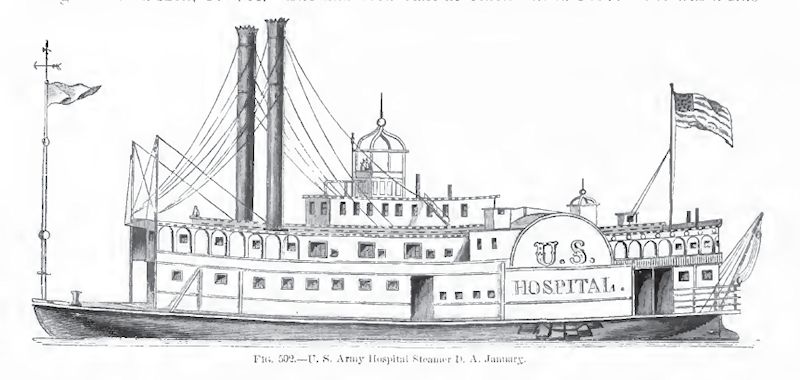
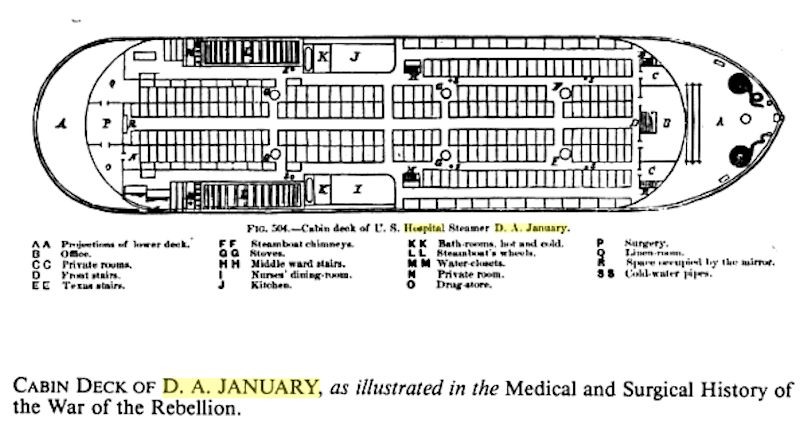
Hospital Steamboat D. A. January
top - sketch of ship
bottom - diagram of cabin deck
where the primary hospital existed
Several soldiers of the 16th Ohio died on the hospital ship D. A. January. It is currently known that Pvt. John McCluggage died here on January 13, 1863, from wounds received at the Battle of Chickasaw Bayou; Pvt. Solomon Parsons died here on April 7, 1863, from typhoid fever. No doubt other 16th Ohio soldiers were cared for and transported to land hospitals on this ship.
History:
Built in Cincinnati, Ohio, 1856; side-wheel steamboat, 450 tons; 225 ft. long; 34 ft. beam; 65 ft. extreme width; two high-pressure engines, 22-inch cylinders, 7 ft. stroke; additional donkey engine
connecting with a steam-pump for fire protection. Purchased by U.S. Government, spring, 1862; after alterations made first trip in April, 1862, to Pittsburg Landing, arriving in middle of Battle of Shiloh, loaded with large supply of hospital stores. Fall, 1862, completely fitted up with all requirements of a general hospital, capacity of 400 beds. Medical officers consisted of one surgeon and three assistant surgeons plus attendants, nurses, cooks, etc.
Ship's captains:
1857-?? J. E. Montgomery
18??-1864 Patrick Yore; possible other captain: J. E. Montgomery
* Samuel Clemens may have been steerman for Capt. Montgomery on a trip December 13, 1857, to January 22, 1858, from New Orleans to St. Louis.
Hospital Ship Service:
Regarding military hospital ships, by order, the operation of all hospital steamers could not be interfered with by any subordinate commanders; once under way with load of sick and wounded they were not disturbed until their destination was reached; flag was considered a flag of truce, fully protected the ship and gave opportunity of keeping hospitals always in order. No persons were allowed passage on the steamers except those connected directly with the medical department of the army.
During March, April, May, June, 1863, this ship laid near Milliken's Bend, Louisiana, serving as floating hospital for armies under General Grant. Altogether, 23,738 patients were carried by her, of whom 530 died en route to land hospitals.
D. A. January hospital commanded by Assistant Surgeon A. H. Hoff, U. S. Army, by order of Major-General Halleck, April 6, 1862; commanded as surgeon-in-charge until February, 1864, when he was succeeded by Surgeon Lewis C. Rice, who commanded until the boat made last trip and was turned over to the quartermaster at St. Louis, Missouri, September 25, 1865.
Final Disposition:
Sold to private owner on March 14, 1865, re-named Ned Tracy.
Snagged on Mississippi River near Chester, Illinois, and destroyed, December 18, 1867.
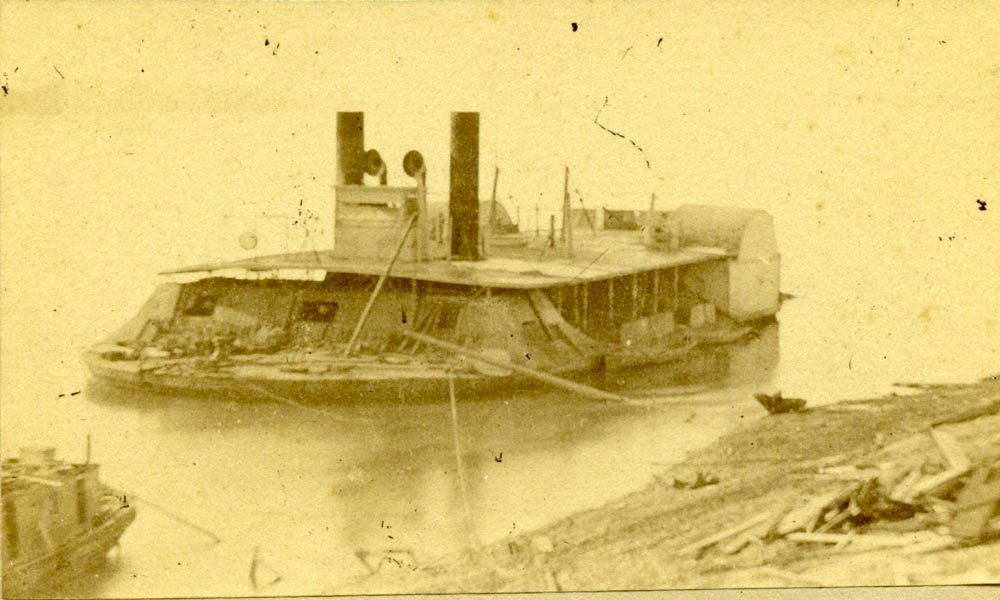
Ironclad U.S.S. Indianola
Photo from collection of Wilson's Creek National Battlefield. Date and location unknown.
Note: Some sources dispuate this is a photo of the Indianola, however, it looks very similar to the artists rendition, below.

Unknown artist's rendition of the U.S.S. Indianola. Image public domain from Wikipedia.
This latest technology ironclad was assigned to guard the entrance to Red River at the Mississippi River. On February 24, 1863, it was captured by Confederates after ramming it multiple times. The Rebels attempted to raise the powerful ship for their own use but ended up scuttling it on the night of February 25 when what they thought was another Union ironclad came bearing down on them. In reality the attacking
ironclad was nothing more than a mock up made to look like a heavily armed gunboat. The idea and construction of the fake gunboat was said to have come from four 16th Ohio Soldiers who, seeing an abandoned coal barge, schemed a way to frighten the Confederates. Read the full story The Ironclad Gunship Hoax.
History:
The Indianola was a side-wheel screw steamer, built in Cincinnati, Ohio, in 1862 by Joseph Brown; launched September 3, 1862; commissioned September 13, 1862. 511 tons; 174 x 50 x 5 ft (length x beam x depth of hold). Armament: two 11" and two 9" Dahlgren smoothbores. Disposition: Lost to enemy action on the Mississippi River, February 24, 1863 by attack of C.S.S. Queen of the West (and other Confederate warships); refloated on January 5, 1865, towed to Mound City, Illinois on January 17, 1865 and sold, final fate unknown.
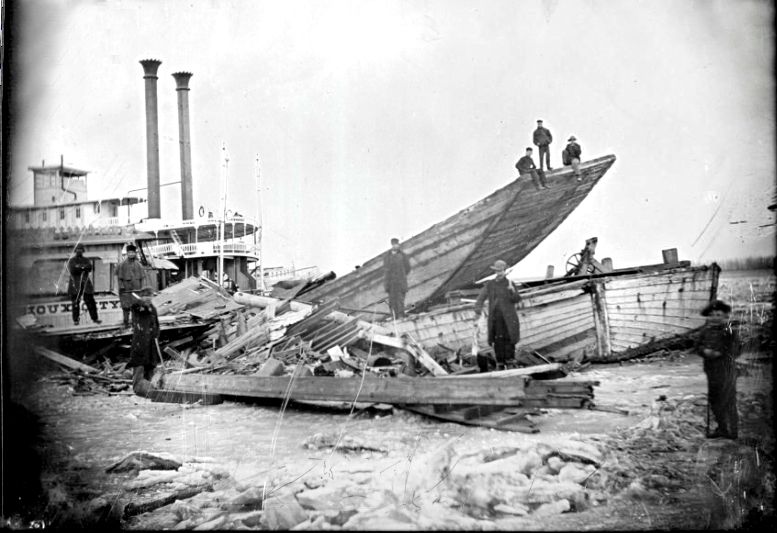
Steamboat Sioux City
Shown after being wrecked by ice in St. Louis, Missouri, December 5, 1865 (later raised).
In his diary, Pvt. Robert Newt
Gorsuch, Company B, tells us that on March 12, 1863, while in winter camp at Milliken's Bend, Louisiana, he stood guard duty on the steamboat Sioux City.
History:
The Sioux City was a side-wheel packet, built in Cincinnati, Ohio, in 1857. 379 tons; 218 x 33 x 5.8 ft (length x beam x depth of hold); wood hull; engines, inside diameter of cylinder 22in, length of piston stroke 7 ft; 3 boilers, each 44 in by 24 ft. First home port, St. Louis. Operated on the Missouri River. Ran trips up the Red River in 1860, and served as a U.S. army transport in 1863-1864. The ship foundered in St. Louis, Missouri, on December 6, 1865, but was later raised.
It is believed that Samuel Clemens and his brother, Orion, travelled from St. Louis to St. Joseph, Missouri, aboard the Sioux City. The experiences of this trip would later form the basis for Mark Twain's book, Rouging It
.

Gunboat U.S.S. Black Hawk
U.S. Naval Historical Center Photograph
The 16th Ohio passed this ship while on board Steamer John H. Gosbeck (no photo available), the morning of April 26, 1864 - see p. 43 of Perrine Diary
History:
USS Black Hawk, a 902-ton side-wheel "Tinclad" river gunboat, was built at New Albany, Indiana, in 1857 as the civilian steamboat New Uncle Sam. She was purchased by the Navy in November 1862 and commissioned the following month under her original name. Soon renamed Black Hawk, her large size made her especially suitable for employment as the Mississippi Squadron flagship, and she served in that capacity under Rear Admirals David Dixon Porter and Samuel Phillips Lee. Black Hawk participated in most of the major Western Rivers operations during the remainder of the Civil War, including the long campaign against Vicksburg in December 1862 to July 1863, the capture of Fort Hindman in January 1863, the attack on Haines Bluff in April-May 1863 and the Red River campaign in 1864. On 22 April 1865, as the great conflict was coming to an end, Black Hawk accidently burned and sank near Cairo, Illinois. Her wreck was salvaged and sold in 1867.
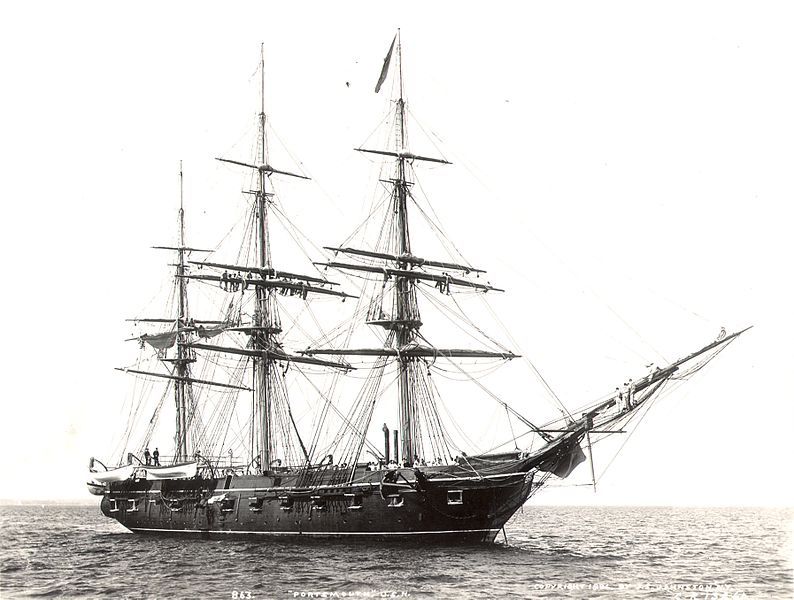
U.S.S. Portsmouth
1896 - Wikipedia, John S. Johnston, photographer
This ship was observed at New Orleans on November 23, 1863, by Drummer Thomas Buchannan and fellow 16th OVI soldier, Raymond Fenner. See reference p.5 Linn Diary.
History:
The second Portsmouth, a wooden sloop-of-war, was launched at the Portsmouth, N.H., Navy Yard 23 October 1843 and commissioned 10 November 1844, Comdr. John B. Montgomery in command. Portsmouth sailed 25 January 1845 for the Mexican coast where she was engaged in watching the movements of British vessels. After the declaration of war with Mexico, 26 April 1846, she shifted to the Pacific and into 1848 cruised off California and Mexico. Returning to Boston in May 1848 she departed again 29 August and sailed east to the African coast. There until 1 February 1849 she patrolled with Royal Navy ships to suppress the slave trade. Between September 1849 and May 1851 she again cruised off the West African coast, returning to Boston 26 June. Six months later Portsmouth left Boston for duty in the Pacific. On 5 April 1855 she returned to the east coast for overhaul at Norfolk and on 3 May 1856 got underway for the Pacific again. She reached Batavia 94 days later, whence she sailed to China. There in November she participated in the engagement with the Barrier Forts. Ordered home in January 1858, she remained at Portsmouth, N.H., until sailing for Africa again for a three year tour, 1859-61. Portsmouth refitted at Portsmouth between September and December 1861, then sailed for the Gulf of Mexico and duty with the Gulf Blockading Squadron. By the end of February 1862 she had captured two blockade runners off Texas. In April she participated in operations against Forts Jackson and St. Philip, then from May 1862 to August 1865 operated as station ship at New Orleans. Continuing her varied career after the Civil War Portsmouth served as quarantine vessel at New York, 1866-67; cruised off Brazil and Africa, 1869-71; carried relief personnel to Brazil in early 1872; and participated in survey assignments in the eastern Pacific, 1873-74. In 1875 she conducted a cruise off the west coast of Latin America and on 14 July 1878 was decommissioned as a cruiser and assigned as a training ship for boys. In 1878 Portsmouth returned to the east coast, arriving at Washington, D.C., 16 February. In March she sailed to France, returning in December to resume training ship duties which she continued until 1911, first with naval apprentices, then with the New Jersey Naval Militia (17 January 1895-March 1911). Portsmouth was then loaned to the Maine Hospital Service, Hampton Roads. She was struck from the Navy List 17 April 1915 and subsequently sold.
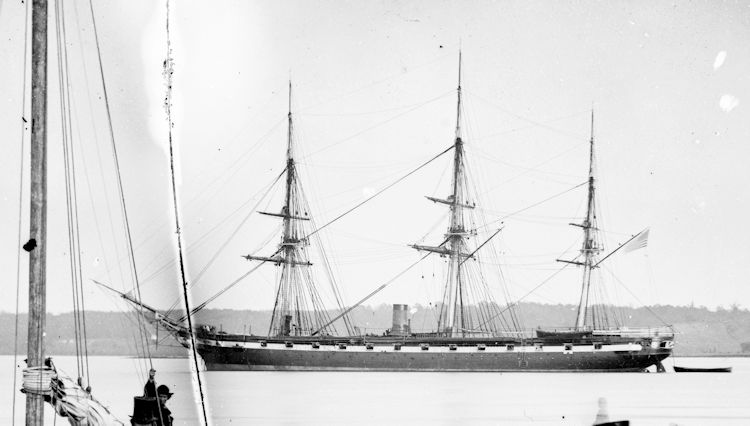
U.S.S. Pensacola
1861 Alexandria, Virginia - Wikipedia
This ship was observed at New Orleans on November 23, 1863, by Drummer Thomas Buchannan and fellow 16th OVI soldier, Raymond Fenner. See reference p.5 Linn Diary.
History:
The first Pensacola was a screw steamer launched by the Pensacola Navy Yard 15 August 1859 and commissioned there 5 December 1859 for towing to Washington Navy Yard for installation of machinery; decommissioned 31 January 1860; commissioned in full 16 September 1861, Capt. Henry W. Morris in command. Pensacola departed Alexandria, Va., 11 January 1862 for the Gulf of Mexico to join Flag Officer Farragut’s newly created West Gulf Blockading Squadron. She steamed with that fleet in the historic dash past Confederate forts St. Philip and Jackson which protected New Orleans 24 April and the next day engaged batteries below that great Confederate metropolis. On the 26th, a landing party raised the Union flag over the mint at New Orleans. During the next two years, she helped guard the lower Mississippi, returning to New York Navy Yard where she decommissioned 29 April 1864 for the installation of new and improved machinery. Recommissioned 16 August 1866, Pensacola sailed round Cape Horn to join the Pacific Squadron, serving from time to time as flagship. Her cruising ranged from Chile to Puget Sound and west to Hawaii. But for two periods in ordinary, 15 February 1870 to 14 October 1871 and 31 December 1873 to 13 July 1874, she continued this duty until detached from the Pacific squadron in June 1883. Departing Callao, Peru 18 July she sailed west across the Pacific and Indian Oceans, transited the Suez Canal, and steamed the length of the Mediterranean, before crossing the Atlantic to arrive in Hampton Roads 4 May 1884. She decommissioned at Norfolk on the 23rd. Recommissioned 4 April 1885, Pensacola operated in European waters until returning to Norfolk in February 1888 for repairs. Operations along the Atlantic Coast and a cruise along the coast of Africa ended when the ship returned to New York in May 1890. In August she headed back to familiar haunts in the Pacific arriving San Francisco 10 August 1891. Following a visit to Hawaii she decommissioned at Mare Island 18 April 1892. Recommissioned 22 November 1898, Pensacola served as a training ship for Naval apprentices until going back into ordinary 31 May 1899. She was back in commission 14 July 1901, subsequently used as receiving ship at Yerba Buena Training Station, San Francisco until finally decommissioning 6 December 1911 and struck from the Navy Register 23 December. She was burned and sunk by the Navy in San Francisco Bay near Hunter’s Point early in May 1912.
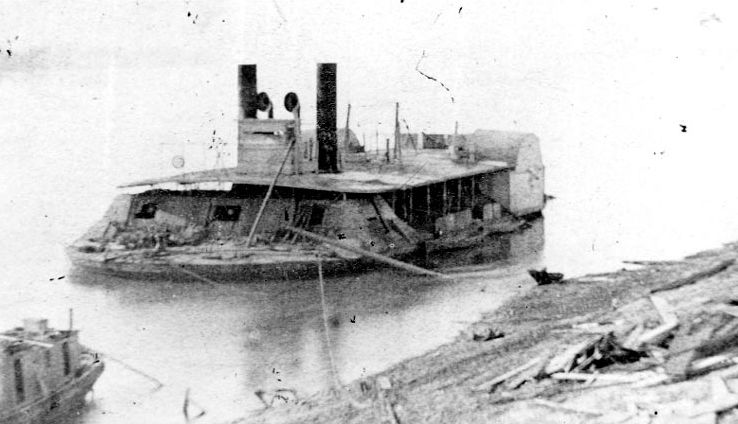
U.S.S. Tuscumbia
ca. 1863 - U.S. Naval Historical Center Photograph
One of eight gunboats reported in diary of Pvt. Peter Perrine as running past batteries at Vicksburg on the night of April 17, 1863, while the 16th OVI was camped near New Carthage, Louisiana (opposite side of river and south of Vicksburg). Reference P.28 Perrine Diary.
History:
USS Tuscumbia, a 575-ton casemate ironclad river gunboat built at Cincinnati, Ohio, was commissioned in March 1863. She was immediately in action, taking part in the recapture of Fort Heiman on 12-14 March. On 1 April, she led a reconnaissance up the Yazoo River. Tuscumbia next participated in the Mississippi Squadron's night-time run past Vicksburg on 16-17 April, during which she towed the damaged transport Forest Queen out of danger. On 29 April, she took part in the attack on Grand Gulf, and was disabled after receiving 81 hits from Confederate artillery. In May, after repairs, Tuscumbia bombarded the Vicksburg batteries. For most of the rest of the Civil War, she was under repair or laid up, being formally decommissioned in February 1865. USS Tuscumbia was sold in November 1865 and abandoned by her owners in 1867.
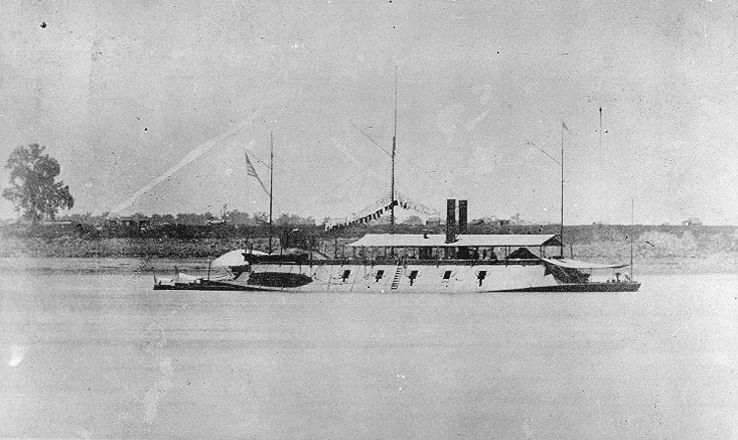
U.S.S. Benton
ca. 1864 - U.S. Naval Historical Center Photograph
One of eight gunboats reported in diary of Pvt. Peter Perrine as running past batteries at Vicksburg on the night of April 17, 1863, while the 16th OVI was camped near New Carthage, Louisiana (opposite side of river and south of Vicksburg). Reference P.28 Perrine Diary.
History:
USS Benton, a 1033-ton ironclad river gunboat, was converted from a catamaran snagboat at Saint Louis, Missouri, for the Army's Western Gunboat Flotilla. Commissioned in February 1862, she took an active part in the Federal operations to open the Mississippi River and its tributaries. In the Spring of 1862, she was present at the captures of Island Number Ten, Fort Pillow and Memphis. During the Summer, Benton was in action with the Confederate ironclad Arkansas near Vicksburg, Mississippi, and participated in an expedition up the Yazoo River. She was transferred to the Navy in October 1862, and continued her service as the Mississippi Squadron's flagship into 1863. In December 1862, Benton was damaged by Confederate gunfire during another operation on the Yazoo River. She was one of the ships that ran past Vicksburg on 16 April 1863 and bombarded Grand Gulf, Mississippi, later in that month. She participated in an attack on Fort DeRussy, Arkansas, in May, then provided gunfire support for the siege of Vicksburg. In March-May 1864, Benton was involved in the Red River expedition, in Louisiana, and returned to that vicinity in June 1865 during operations that followed the formal end of the Civil War. USS Benton was decommissioned in July 1865 and sold the following November.
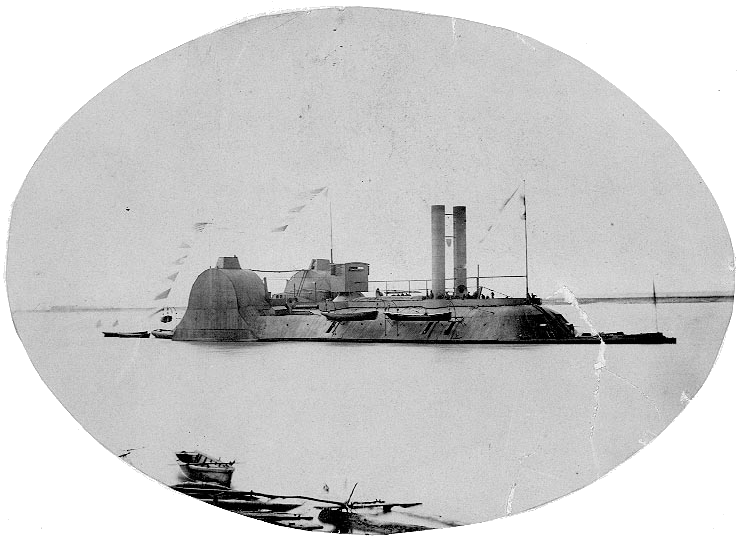
U.S.S. Lafayette
ca. 1864 - U.S. Naval Historical Center Photograph
One of eight gunboats reported in diary of Pvt. Peter Perrine as running past batteries at Vicksburg on the night of April 17, 1863, while the 16th OVI was camped near New Carthage, Louisiana (opposite side of river and south of Vicksburg). Reference P.28 Perrine Diary.
History:
SS Lafayette, a 1193-ton ironclad river gunboat and ram, was originally built in 1848 as the side-wheel merchant steamer Aleck Scott. She was used by the Army as a quartermaster ship under the name Fort Henry in 1861-62. Renamed Lafayette in September 1862, she was undergoing conversion to an ironclad in October when her ownership was transferred to the Navy. Her new arrangement was designed by Commodore William D. Porter, and, like other ships prepared to his plans, was less-than-satisfactory -- her armor, which used rubber backing to supposedly enhance its shot resistance, proved inadequate, and the ship was overweight and much too slow for use as a ram. Her appearance, on the other hand, was impressive. Despite her deficiencies, Lafayette had an active career in the Mississippi Squadron. Commissioned in February 1863, and initially commanded by Captain Henry Walke, on 16 April 1863 she took part in Rear Admiral David Dixon Porter's daring run past the Confederate fortress at Vicksburg, Mississippi. Later in the month, Lafayette and other ships of the squadron bombarded Grand Gulf, another step in the campaign that ultimately opened the Mississippi to unobstructed use by the Union. In May, the ironclad and her consorts briefly operated on the Red River, in Louisiana. Lafayette spent most of the rest of the Civil War in the lower Mississippi River area, including participation in the great Red River expedition in March-May 1864. She was decommissioned in July 1865 and laid up at New Orleans. USS Lafayette was sold in March 1866 and broken up.
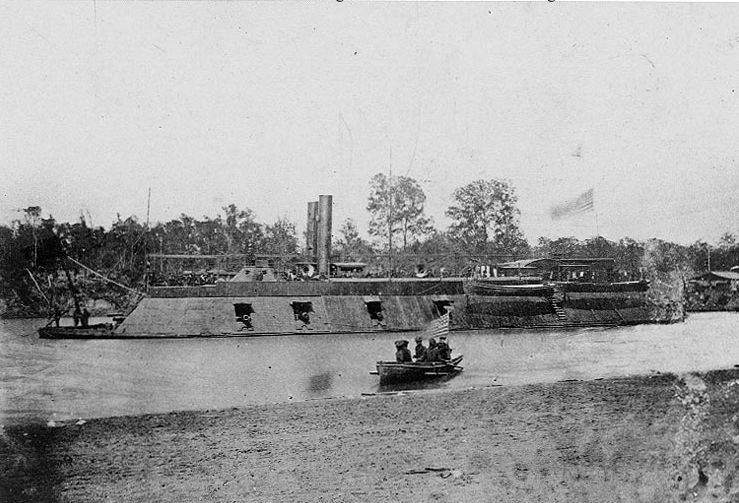
U.S.S. Pittsburg
ca. 1862-1865 - U.S. Naval Historical Center Photograph
One of eight gunboats reported in diary of Pvt. Peter Perrine as running past batteries at Vicksburg on the night of April 17, 1863, while the 16th OVI was camped near New Carthage, Louisiana (opposite side of river and south of Vicksburg). Reference P.28 Perrine Diary.
History:
USS Pittsburg, a 512-ton Cairo class ironclad river gunboat, was built at Saint Louis, Missouri. Commissioned in January 1862 as part of the U.S. Army's Western Gunboat Flotilla, she was damaged in action during the bombardment of Fort Donelson, Tennessee, in February. After repairs, she took part in the successful sieges of the Island Number Ten fortress in March and April and Fort Pillow in May. Late in 1862 and during the first part of 1863, following her transfer from the Army to the Navy in October 1862, Pittsburg participated in operations on the Yazoo River and Steele's Bayou, Mississippi. In April 1863, she was one of the ships that ran past the Confederate batteries at Vicksburg and attacked fortifications at Grand Gulf. Pittsburg's later operations included participation in the Red River expedition of March-May 1864. She was decommissioned following the end of the Civil War and was sold in November 1865.
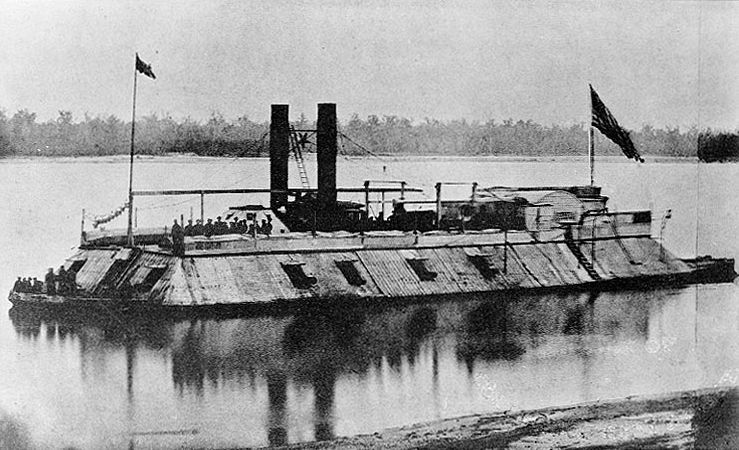
U.S.S. Carondelet
ca. 1862-1865 - U.S. Naval Historical Center Photograph
One of eight gunboats reported in diary of Pvt. Peter Perrine as running past batteries at Vicksburg on the night of April 17, 1863, while the 16th OVI was camped near New Carthage, Louisiana (opposite side of river and south of Vicksburg). Reference P.28 Perrine Diary.
History:
USS Carondelet, a 512-ton Cairo class ironclad river gunboat, was built at Saint Louis, Missouri, for the U.S. Army's Western Gunboat Flotilla. Commissioned in January 1862 with Commander Henry A. Walke, USN, as her captain, Carondelet quickly entered combat, taking part in the captures of Forts Henry and Donelson, Tennessee, in February 1862. In March and April, she played an important role in the campaign to capture the Confederate fortress at Island Number Ten, on the Mississippi River. This was followed by operations against Fort Pillow and Memphis, Tennessee, during April-June 1862. With the upper Mississippi now under Union control, Carondelet spent much of the following year in the long campaign against Vicksburg, Mississippi. On 15 July 1862, while in the Yazoo River, she was badly damaged in an engagement with the Confederate ironclad Arkansas. Along with the other units of the Army's Western Rivers navy
, she was formally transferred to the U.S. Navy in October 1862. In April 1863, Carondelet was a member of the ironclad force that ran past Vicksburg and later bombarded Grand Gulf, Mississippi. In May, she participated in extensive bombardments of Vicksburg, part of the combined Army-Navy operations that led to that fortified city's surrender on 4 July 1863. Thereafter, she was involved with a variety of expeditions and patrol operations, among them the March-May 1864 Red River expedition. Decommissioned in June 1865, USS Carondelet was sold in November of that year. Her hull was subsequently used as a civilian wharfboat, while her engines were installed in another river steamer.
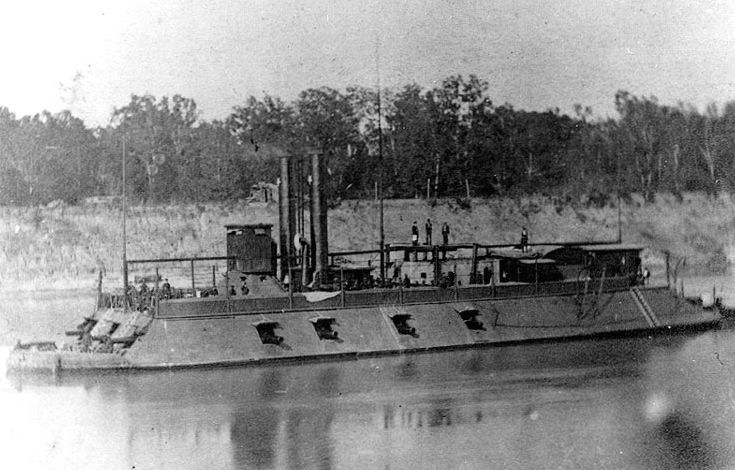
U.S.S. Mound City
ca. 1862-1865 - U.S. Naval Historical Center Photograph
One of eight gunboats reported in diary of Pvt. Peter Perrine as running past batteries at Vicksburg on the night of April 17, 1863, while the 16th OVI was camped near New Carthage, Louisiana (opposite side of river and south of Vicksburg). Reference P.28 Perrine Diary.
History:
USS Mound City, a 512-ton Cairo class ironclad river gunboat, built at Mound City, Illinois, for the U.S. Army's Western Gunboat Flotilla. was commissioned in January 1862. She was actively engaged in combat operations during the later winter and spring of 1862, participating in the action at Columbus, Kentucky, in February, the capture of the Island Number Ten fortress in March and April, and operations against Fort Pillow in May. She was twice rammed by Confederate steamers off Fort Pillow on 10-11 May, requiring her withdrawal for repairs. Mound City returned to action in June and was badly damaged by enemy cannon fire during a bombardment at St. Charles, Arkansas. Repaired again, she was involved in operations in the Yazoo River, Vicksburg and Grand Gulf campaigns during 1862-63. In March-May 1864, Mound City participated in the Red River expedition. Her activities during the remainder of the Civil War involved guard and patrol duties and excursions up Mississippi River tributaries. Decommissioned after the end of the conflict, USS Mound City was sold in November 1865 and broken up in 1866.
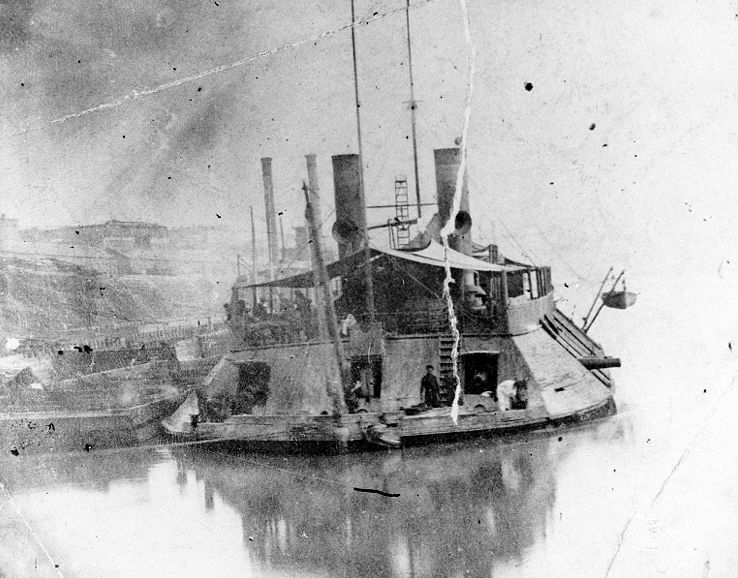
U.S.S. Louisville
ca. 1862-1865 - U.S. Naval Historical Center Photograph
One of eight gunboats reported in diary of Pvt. Peter Perrine as running past batteries at Vicksburg on the night of April 17, 1863, while the 16th OVI was camped near New Carthage, Louisiana (opposite side of river and south of Vicksburg). Reference P.28 Perrine Diary.
History:
USS Louisville, a 512-ton Cairo class ironclad river gunboat, was built at Saint Louis, Missouri, and commissioned in January 1862. During February - June 1862, while serving in the U.S. Army's Western Gunboat Flotilla in a successful campaign to secure the upper Mississippi and its tributaries, she participated in actions at Fort Donelson, Island Number Ten, Memphis and Vicksburg. Transferred to the Navy in October 1862, Louisville took part in operations above Vicksburg during the rest of that year and into 1863. In April 1863, she was one of the Federal ships that ran past Vicksburg's batteries and later engaged Confederate fortifications at Grand Gulf. In March, April and May 1864, Louisville was a unit of the squadron operating in support of the Red River campaign. She remained active on the Western Rivers until the end of the Civil War. Decommissioned in July 1865, USS Louisville was sold in November 1865.

U.S.S. General Sterling Price
ca. 1862-1865 - U.S. Naval Historical Center Photograph
One of eight gunboats reported in diary of Pvt. Peter Perrine as running past batteries at Vicksburg on the night of April 17, 1863, while the 16th OVI was camped near New Carthage, Louisiana (opposite side of river and south of Vicksburg). Reference P.28 Perrine Diary.
History:
USS General Price, a 633-ton side-wheel river steamer, was built at Cincinnati, Ohio, in 1856 as the commercial towboat Laurent Millaudon. She served the Confederacy as the ram CSS General Sterling Price in 1861-62 and was sunk on 6 June 1862 during the Battle of Memphis, Tennessee. Raised and repaired by Federal forces, she was commissioned for U.S. Navy service in March 1863 as USS General Price, though her old name also continued to be used. General Price was involved in the Vicksburg campaign in March and April 1863, and took part in the Mississippi Squadron's run past the Confederate fortress city on 17 April. During the rest of the Civil War, she operated against Grand Gulf and Vicksburg, in the Red and Black Rivers and elsewhere in the lower Mississippi River area. On 8 March 1864, General Price accidently rammed and sank USS Conestoga. She took part in the Red River Expedition during the next month. Decommissioned in July 1865, USS General Price was sold the following October.

U. S. Hospital Ship Nashville
ca. 1862-1865, Library of Congress
This is the United States hospital ship Nashville, on which Pvt. John H. McKeever, Company F, died of disease, on August 15, 1863. Lt. Martin Hugh Norton, Company C, also died of disease on this ship two days later, August 17, 1863. This image of the ship believed to have been taken while docked at Vicksburg, Mississippi, date unknown.
History:
Sidewheel Packet/Hospital boat
BUILT: 1849 at New Albany, Indiana
OWNERS: Captain Tyner and W.W. Parmenter
OFFICERS & CREW: Captain Thomas Bellanyder; John Orr (clerk)
RIVERS: Cumberland River; Canary Fork River
OTHER INFORMATION: Her hull was made by Dowerman and Humphries. First home port, Louisville, Kentucky. She ran Nashville-New Orleans and could carry 100 passengers. At the beginning of the Civil War (1862) she was converted to become the U.S. Sanitary Commission's hospital boat. Her two decks could hold 1000 wounded. She kept the name Nashville.
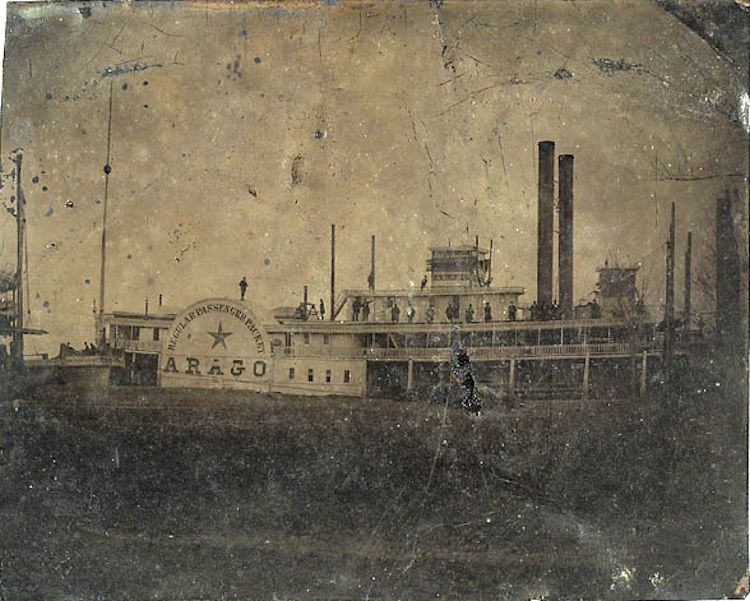
Steamship Arago
ca. 1861-1865 - image obtained from Cowan's Auctions
The steamship Arago which transported Pvt. Peter Shelly, Company I, from Memphis, Tennessee to Vicksburg, Mississippi, November 5 through 10, 1863, during his journey back to the regiment after being captured at the Battle of Chickasaw Bayou on December 29, 1862, and later paroled and exchanged. Shelly's diary may imply other 16th Ohio soldiers were with him at some point on this journey which started, at least for Shelly, in Wooster, Ohio, on October 20 and ended with rejoining the regiment in Algiers, Louisiana, on November 22, 1863. Just three days later, Shelly and the regiment left for their next deployment to Matagorda Bay, Texas. Reference Shelly diary, p. 10. Note: this ship was piloted by the famous riverboat captain and author, Samuel Clemens, before the war began, just three years earlier.
History:
Steamboat: ARAGO Built: 1860 Tonnage: 268 Clemens' Service: 28 July - 31 August 1860 Co-Pilot: Isaiah W. Bill
Hood [identification of Bill
Hood was made by researcher Michael Marleau, Nov. 2006] Captain: George P. Sloan Fate: Burned in Dog Tooth Bend, near Commerce, MO on Feb. 6, 1865.
Like many inland water steamers, the Arago was built at Brownsville, Pennsylvania, and left the skids in March, 1860 on her first trip bound for St. Louis. From there she joined three other packets in St. Paul, Minnesota to form the St. Louis, Arkansas River and Vicksburg Line. On July 31, 1860, the Arago left St. Louis for Vicksburg, with Samuel Clemens standing pilot watch, with J.W. Hood acting as his partner. George Sloan was the boat's master, and principal owner. Returning to Cairo on August 11th, the packet left the following day for New Orleans, and returned to St. Louis on August 31. It was during the trip from New Orleans to St. Louis that Clemens penned "The Pilot's Memoranda" that he and Hood published on August 31st. Afterwards, Clemens piloted one more boat, The Alonzo Child
; with the outbreak of the Civil War, his days as a riverboat man were ended. This image of the Arago was likely taken not long after the outbreak of the war, as attested by the iron railing around the lower part of the pilot house. Initially placed here to fend of shot and cannonballs, this light armoring eventually gave way to the famous tinclads
of the Brown-water Navy.
Starlight
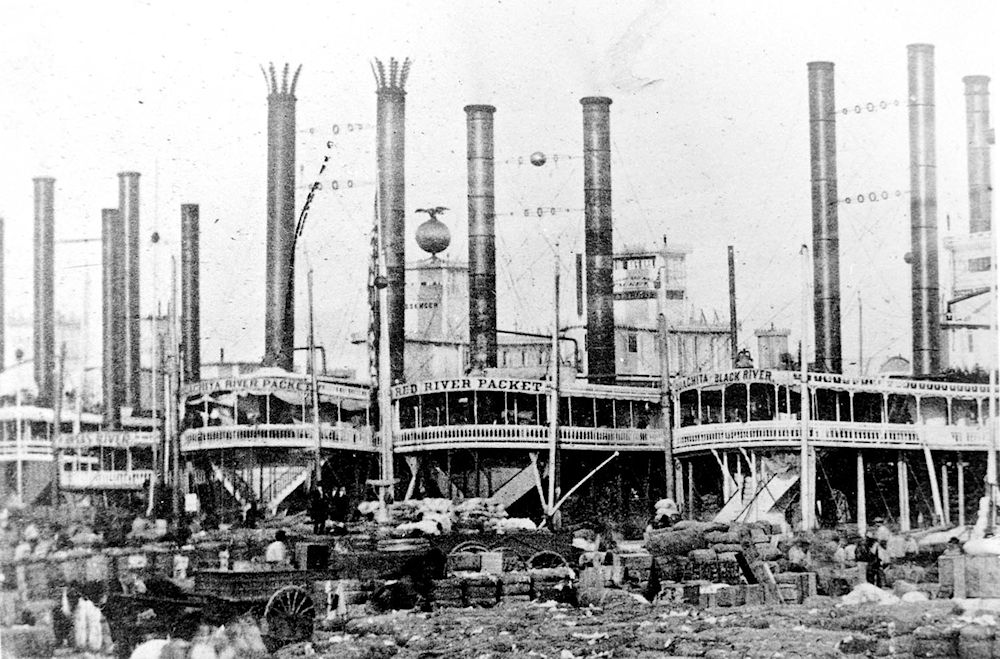
Steamship Starlight
image courtesy of and with permission from the Murphy Library, University of Wisconsin-La Crosse, Special Collections
shown docked at New Orleans in 1859, the Starlight is the second boat from right with Red River Packet
sign on front
Assumed to be the same boat, the steamship Starlight, shown above, second from right, was referenced by Pvt. Thomas Linn in his diary at Linn Diary observed while the regiment was returning from the Second Bayou Teche campaign on November 9, 1863, on Bayou Teche, several miles northwest of Berwick, Louisiana. There are other steamboats named Starlight so it cannot be confirmed that the above is the same as what the 16th Ohio observed.
History:

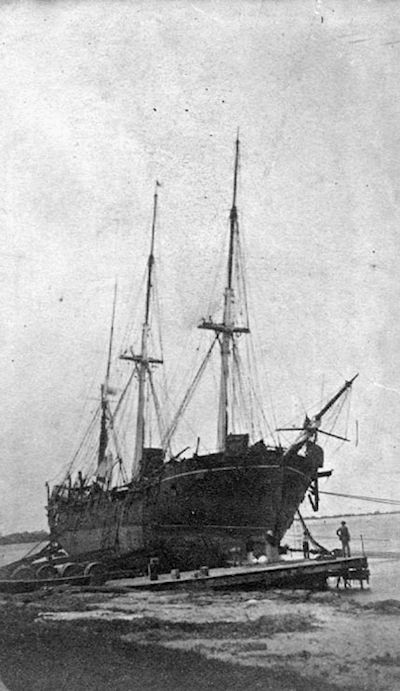
Gunboat U.S.S. Monongahela
U.S. Naval Historical Center Photographs
top: artist's rendition of original configuration used during Civil War
bottom: photograph of ship set aground by tidal wave on Frederikstad, St. Croix, Virgin Islands, March 4, 1868 (refloated May 11, 1868)
In the winter and spring of 1864, troops of the 16th Ohio observed the large U.S. Navy gunship U.S.S. Monongahela, shown above, lying in Pass Cavallo, the waterway between the eastern end of Matagorda Island and Decrow's Point on the western tip of Matagorda Peninsula. The Monongahela had been assigned blockade duty in the Gulf of Mexico and was assisting Union forces along the Texas coast. The troops also noted the ship captured two small Rebel schooners that were, apparently, trapped in Matagorda Bay during that time.
History:
USS Monongahela, a 2078-ton Barkentine steam screw sloop built at the Philadelphia Navy Yard, Pennsylvania, was commissioned on January 15, 1863. Her first service was on the lower Mississippi River, where she was heavily engaged at Port Hudson and elsewhere. From mid-1863 to the end of the Civil War, Monongahela participated in the Gulf of Mexico blockade. On 5 August 1864, she played an active role in the Battle of Mobile Bay, ramming the Confederate ironclad Tennessee. Following the War, Monongahela was assigned to the West Indies. On 18 November 1867, she was cast ashore at St. Croix, Virgin Islands, by a tidal wave and was only refloated six months later. In 1873, after extensive repairs, she began six years' service in the Pacific, the western Atlantic and in Asiatic waters. Monongahela was converted to a sailing storeship in 1883-84, with her engines removed to increase storage space. From then until 1890, she served as supply vessel at Callao, Peru. Monongahela's next role was as a ship-rigged sail training ship for apprentice seamen and, from 1894 to 1899, for the U.S. Naval Academy's midshipmen. Her training duties ended in 1904, when she became storeship at Guantanamo Bay, Cuba. Monongahela was destroyed by fire there on 17 March 1908.
Displacement 2,078 t.
Length 227'
Beam 38'
Draft 17' 6"
Speed 8.5 kts.
Complement unknown
Armament: one 200-pdr Parrot Rifle; two 11" smooth bore; two 24-pdrs; two 12-pdrs;
Propulsion steam and sail
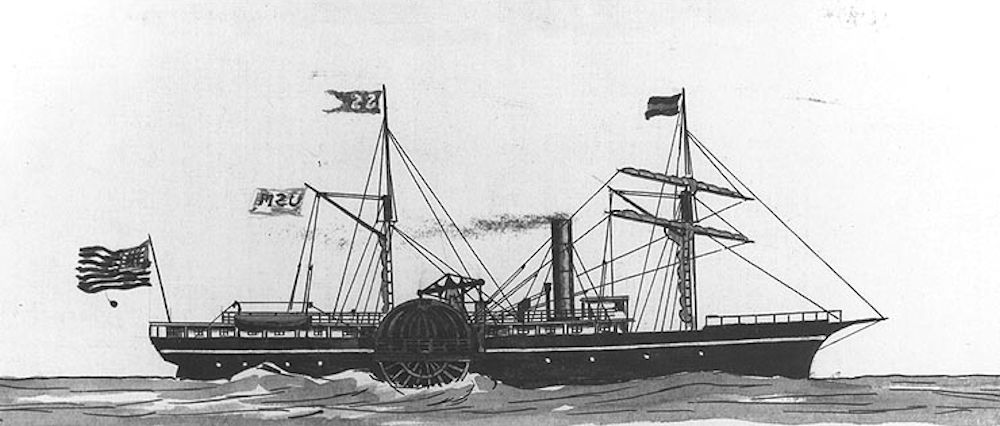

Gunboat S.S. Tennessee/U.S.S. Tennessee
top: artist's rendition at U.S. Naval Historical Center as it may have looked in 1853
bottom: artist Clement Drew's (1806-1889) rendition titled Tennessee 1860
The 16th Ohio was transported on two steamships, the Exact and the Alliance, from Matagorda Island, Texas, on April 18, 1864, arriving in New Orleans on the afternoon of April 21. During the voyage, on the night of April 19, the U.S. sloop-of-war Tennessee, thinking the Alliance was a Confederate blockade runner, attacked the ship, firing five shots. The Alliance thought the Tennessee was the privateer Alabama. The Alliance capitulated and, once the two ships identified each other as friendly, went on its way to New Orleans. See 16th OVI references at p.42 Perrine Diary and Camp and Field, ch. 70.
Note: This website previously referred, incorrectly, to the Confederate ironclad C. S. S. Tennessee (later captured by the U.S. and renamed U.S.S. Tennessee) as the ship referenced by 16th Ohio soldiers. Subsequent information has identified the correct ship, now listed here.
History:
The Tennessee, a 1275-ton (burden) wooden-hulled side-wheel steamship, was built at Baltimore, Maryland, in 1853. Prior to the Civil War she was employed in commercial service. Caught at New Orleans, Louisiana, after the conflict began, she was seized there by Confederate authorities in January 1862 and may have been used to run the Federal Blockade during the next month. When Federal forces captured New Orleans in April, Tennessee was also taken. Soon purchased by the U.S. Navy, she was commissioned as USS Tennessee in May 1862. A fast vessel, she was employed in the Gulf of Mexico on blockade, supply and dispatch duties for almost all of the remaining portion of the Civil War. Among her activities were the capture of several sailing blockade runners; participation in an action at White Hall Point, Louisiana, on 10 July 1863 and in the campaign to capture the entrances of Mobile Bay in August 1864. Once the U.S. Navy had taken the former Confederate ironclad Tennessee into its own service, the Navy's older Tennessee needed renaming. Accordingly, at the beginning of September 1864 she became USS Mobile. During the last months of 1864 and into 1865, Mobile continued her service in the West Gulf Blockading Squadron. However, her increasing need for repairs, some of it caused by age and some by severe storm damage received off the Rio Grande in late 1864, led to her decommissioning. Sold towards the end of March 1865, the steamship returned to commercial employment under the name Republic. Her new career was short, though. On 25 October 1865 she was lost in a hurricane off Savannah, Georgia.
from Naval Historical Center, Department of the Navy, Washington, D. C.
Launched: August 13, 1853 as S. S. Tennessee
Length: 210 ft.
Beam: 33 ft 11 in.
Draft:
Displacement: 1,149 tons
Type: sidewheel steamer with sails
Disposition: sunk during hurricane on October 25, 1865, about 100 miles southeast of Savannah, Georgia, at about 1700 feet in depth; the shipwreck was located in 2003 and found to have a large payload of gold coins bound for New Orleans to assist with Southern reconstruction.
Notes: fitted with a vertical beam engine with massive, steam powered single piston powered by two double return flue boilers; drove two 28-foot dia. iron sidewheels; could transport 100 passengers and 5,000 barrels of cargo.
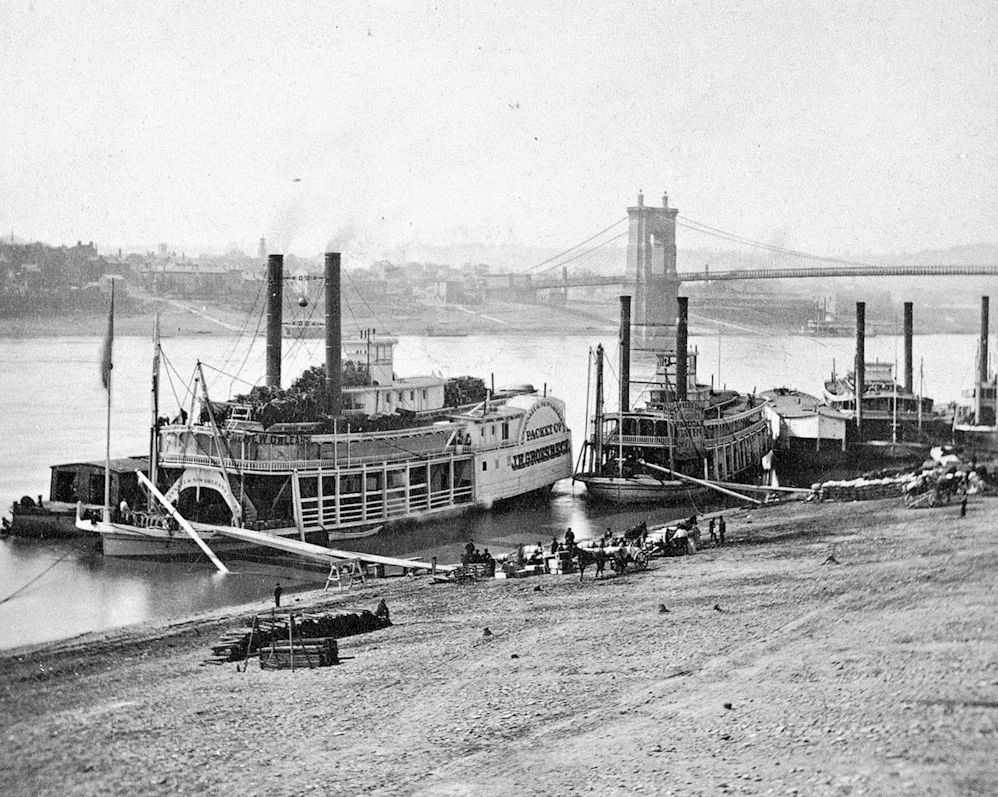
Steamship John H. Groesbeck
image taken by Charles Waldack and courtesy of and with permission from the Murphy Library, University of Wisconsin-La Crosse, Special Collections
shown docked at Cincinnati (or Covington, Kentucky) between 1863 and 1872
The steamship John H. Groesbeck, shown above, transported the 16th Ohio from New Orleans, Louisiana, to Alexandria, Louisiana, on April 24 through 26, 1864. The regiment had been sent to Alexandria to reinforce Gen. Nathaniel Banks who was being pursued by Confederate forces from the west. Referenced at Perrine diary, p. 43.
History:
Type: sidewheel steamboat - packet
Built: 1863, Cincinnati, Ohio
Owners: Capt. Dan Maratta (1866)
Notes: First home port, Cincinnati, Ohio; ran Memphis-New Orleans in 1866; last of the short-length sidewheelers designed for passage through the Louisville-Portland locks

Steamship City Belle
image pending permission from the Murphy Library, University of Wisconsin-La Crosse, Special Collections
shown (left) docked somewhere on the Missouri River next to the Calypso
The steamship City Belle was carrying the 120th Ohio Volunteer Infantry up the Red River toward Alexandria, Louisiana, to reinforce the Union troops of Gen. Nathaniel Banks, currently stationed in and around that city. Banks' army was in retreat from the troops of Confederate General Richard Taylor, who had defeated Banks' attempt at moving on Shreveport and was pushing him back toward the Mississippi River. On May 3, 1864, about 12 miles from Alexandria, the City Belle encountered a Rebel ambush at Snaggy Point. The ship was torn to pieces by Confederate artillery and heavy rifle fire, most of the regiment being killed or captured. The Rebels then captured the steamship and burned it. The ship and event were referenced by 16th Ohio soldier Cpl. Theodore Wolbach, Company E, in his series of articles entitled Camp and Field, which chronicle the history of the regiment.
History:
CITY BELLE
Type: Sidewheel, wooden hull packet. Size: 179' X 35' X 5.', 152 tons.
Launched: 1855, Paducah, Ky.
Destroyed: 1864, May 4, Red R. near Snaggy Point,
Was hit by shell from Rebel guns, which burst a boiler. Capt. Tally was thrown into river and escaped to shore. Nearly all hands were killed, as well as a number of soldiers. Boat was pulled ashore by Rebels and burned.
Area: 1855 out of Memphis.
1864, Jan 24, arrived Memphis with 500 sick and wounded U.S. troops.
1864, March, Louisville-Memphis
1864, Red River
Owners: 1861- end, was in USQMC service
Captains: 1864, Tally
Comments: was en route to Alexandria with an Ohio Regiment when lost.
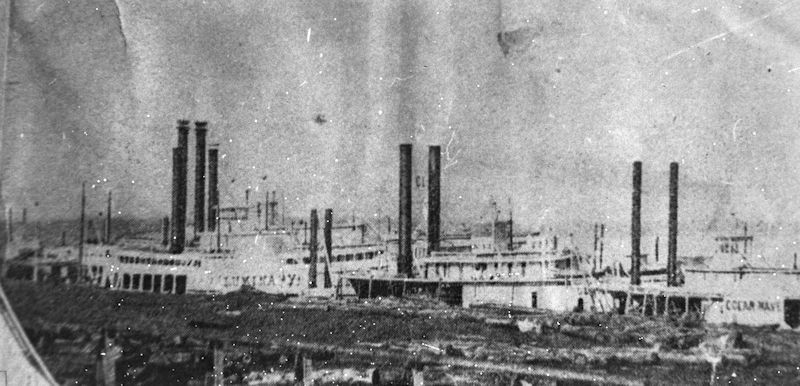
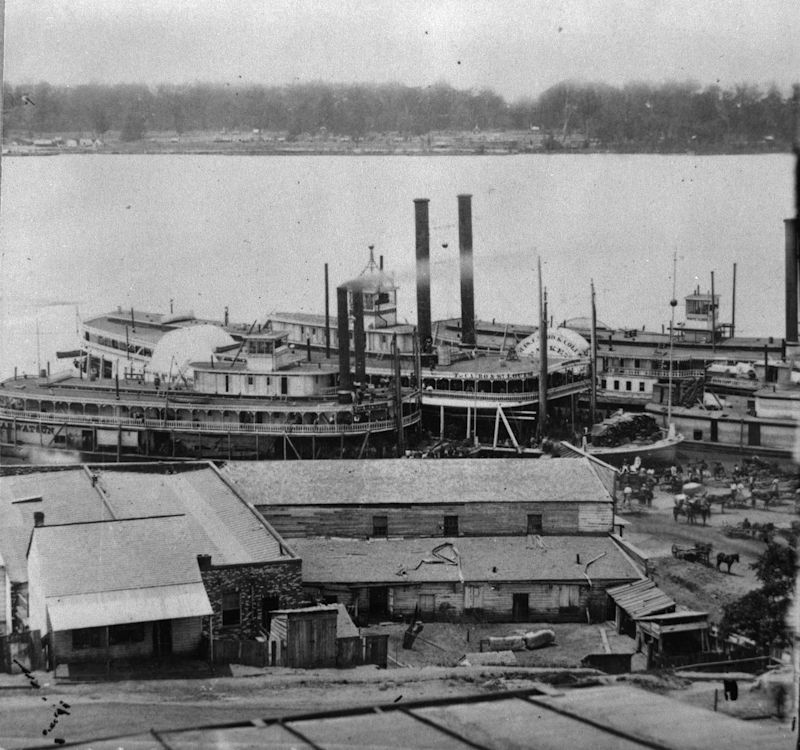
Steamboat Luminary
images courtesy of and with permission from the Murphy Library, University of Wisconsin-La Crosse, Special Collections
The steamship Luminary, shown above (top) in 1863 at Cairo, Illinois, and (bottom) in 1864 at Vicksburg, Mississippi, in between two other boats and with the tallest stacks, transported the 16th OVI on its journey home from Morganza, Louisiana, departing October 6, 1864. The regiment arrived in Cairo, Illinois, on October 12, 1864, where the troops took the railroad through Illinois, Indiana and to Columbus, Ohio, where they were officially mustered out on October 31. Reference Shelly diary, p. 17.
History:
BOAT DESCRIPTION: Sidewheel BOAT TYPE: Packet BUILT: 1863 at Cincinnati, Ohio at the John Litherbury yard.
Her machinery was by Moore and Richardson. She was launched on January 3, 1863 in a double ceremony with the Sultana.
| Transportation Index Page | 16th OVI Home Page | Next Transportation Page |